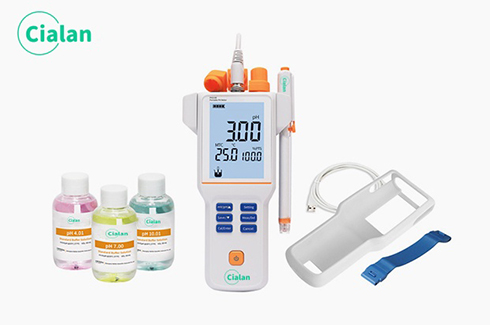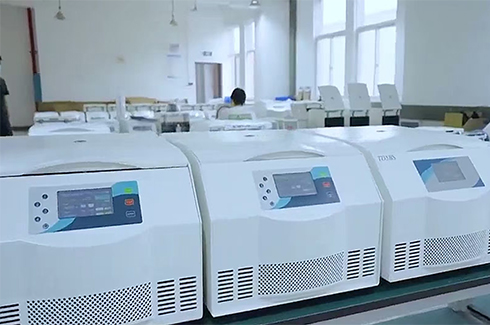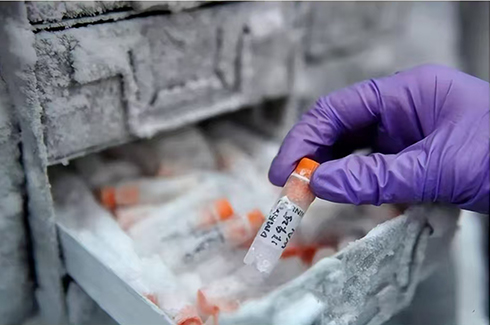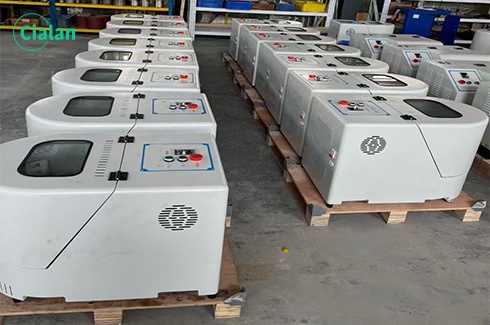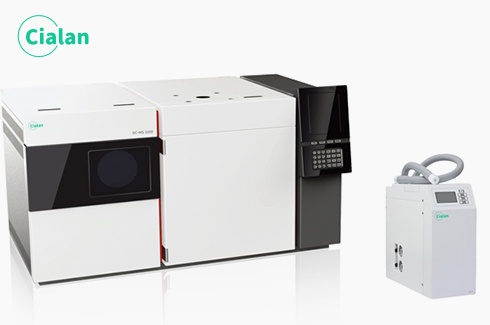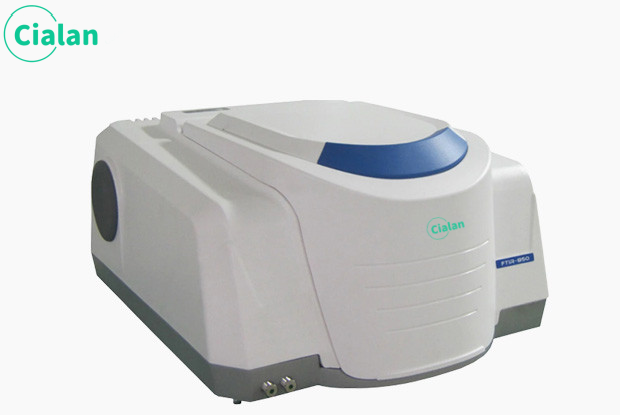Application area to GC-MS.
What is GC-MS?
GC-MS is widely used in the separation and identification of complex components, with the high resolution of GC and the high sensitivity of mass spectrometry. GCMS can quickly obtain molecular weight information for synthesized compounds without the need for sample preparation.
Mass spectrometry (MS) is a spectrum of mass. The molecules of a substance form charged particles through physical action or chemical reaction under high vacuum. Some charged particles can be further broken. The ratio of the mass of each ion to its charge is called the mass-to-charge ratio (m/z, formerly m/e). After the ions with different mass-to-charge ratios are separated one by one by the mass separator, the mass-to-charge ratio and relative intensity of each ion are measured by the detector, and the resulting spectrum is called a mass spectrum. Mass spectrometry is an analysis method that ionizes analytes, separates them according to their mass-to-charge ratio, and achieves the purpose of analysis by measuring the peak intensity of the ions.
High-performance gas chromatography thermal cracking sample injection analysis is that under certain conditions, polymer organic matter follows certain cracking rules, that is, a specific sample can produce specific cracking products and product distribution. High-performance gas chromatography is used to analyze and identify the cracking products, which can be based on This characterizes the original sample.
.jpg)
Basic principles of gas phase mass spectrometry.
The polymer sample is placed in a cracker, and under strictly controlled operating conditions, it is rapidly thermally cracked at high temperature to generate volatile small molecule products, and then the cracked products are sent to a gas chromatograph for separation and analysis. Because the composition and relative content of cracked fragments are closely related to the structure of the polymer to be measured, the cracked chromatogram of each polymer has its own characteristics, so the cracked chromatogram is also called a thermal cracking fingerprint chromatogram.
Requirements for cracker.
1. Due to different pyrolysis temperatures and different pyrolysis products, the pyrolysis temperature control must be accurate and repeatable.
2. Different substances require different cracking temperatures, and the cracking temperature must be adjustable.
3. The cracker has large heat capacity and fast heating speed.
4. The cracker and interface should be small in size to reduce dead volume and prevent chromatographic peaks from broadening.
5. No catalytic reaction for cracking reaction, preventing disproportionation reaction and secondary reaction.
Cracker types.
1. Tube furnace cracker:
The tube furnace cracker is usually made of a quartz tube with an outer wall heated, and is heated by an electric heating wire. The cracking temperature ranges from 300 to 1000°C, and the constant temperature accuracy is high. When the furnace temperature reaches the set temperature, place the sample in the platinum boat, and use a push rod to send the platinum boat into the cracking furnace without the sample in contact with the tube wall.
The tube furnace cracker has a simple structure, can quantitatively inject samples, is easy to operate, and has continuously adjustable cracking temperature. However, the heating rate is not adjustable, the dead volume is large, and secondary reactions are easy to occur.
2. Hot filament cracker:
The hot wire cracker is usually made of platinum wire or nickel chromium wire with a diameter of 0.2~0.5mm and a length of about 50mm wound into a spiral shape. The sample is coated on the metal hot wire, and the hot wire is heated to the required temperature with a stable voltage. Sample lysis.
The hot filament cracker has a simple structure, short heating time and few secondary reactions. However, it is not easy to quantitatively sample and is generally only used for qualitative analysis.
3. Curie point cracker:
Curie point cracker is a high-frequency induction heating cracker that uses ferromagnetic materials as heating elements. When it is placed in a high-frequency electric field, it will absorb radio frequency energy and heat up rapidly. When it reaches the Curie point temperature, the ferromagnetic material becomes paramagnetic and no longer absorbs radio frequency energy, and the temperature stabilizes at the Curie point temperature. When the high-frequency power supply is cut off and the temperature drops, the ferromagnetism is restored. By attaching the sample to a heating element, the sample can be lysed at the Curie point temperature.
Different ferromagnetic materials have different Curie point temperatures. By adjusting the composition of the ferromagnetic alloy, a heating element with the required temperature can be obtained.
4. Laser cracker. This is a new type of cracker that will gradually be widely used with technological breakthroughs.
Features.
1. High separation efficiency: Most thermal cracking gas chromatographs use capillary chromatography columns, which can effectively separate complex pyrolysis products, especially small differences between polymer organic matter and trace components in polymer materials. Sensitively reflected on fragmentation chromatograms to find corresponding features.
2. High sensitivity: Thermal cracking gas chromatograph generally uses hydrogen flame ionization detector, which has high sensitivity.
3. Small amount of sample: The amount of sample is generally in the range of μg to mg, which is very beneficial for detection where only trace amounts of samples can be obtained.
4. Fast analysis speed: The typical analysis cycle is 30 minutes. When the cleavage products are complex, an analysis can be completed in 1 to 2 hours.
5. Large amount of information: Qualitative and quantitative analysis can be carried out, and the relationship between cracking conditions and cracking products, the relationship between sample structure and cracking products, cracking mechanism and reaction kinetics can be studied.
6. Wide range of applications: Suitable for samples of various forms without pretreatment. Whether they are viscous liquids, powders, fibers and elastomers, or cured resins, coatings and vulcanized rubbers, they can be directly injected for analysis.
7. Easy to popularize: The cracking injector has a simple structure and can be combined with a gas chromatograph for separation and analysis.
8. Can be connected online with various spectroscopic instruments: Any spectroscopic instrument that can be connected online with a gas chromatograph can be connected online with a thermal cracking gas chromatograph.
Applications:
It is suitable for the separation and analysis of substances with large molecular weight, complex structure, difficult to volatilize and difficult to dissolve.
In pharmaceutical analysis, flash evaporation technology can be used to analyze volatile components in Chinese herbal medicines. The so-called flash evaporation means that before the sample is cracked, the sample is rapidly heated at a lower temperature (lower than the cracking temperature of the sample) to evaporate the volatile components and obtain a chromatogram. The sample is then cracked at high temperature to obtain a cracking chromatogram. In this way, important information about the volatile components in the sample can be obtained, which is very useful in the qualitative identification of the sample.
Identification of polymers using fragmentation-gas chromatography is performed by comparing the fragmentation spectra of unknown samples with those of standard samples, a so-called "fingerprint" identification. The fingerprints of standard samples can be stored in a computer database or obtained through parallel experiments with unknown samples during identification. No matter which method is used, it is required that the spectra being compared are obtained under the same experimental conditions.
Although the fingerprint identification method is intuitive and convenient, it is not strict. Sometimes it is difficult to accurately judge some polymers with similar structures.
Gas chromatography mass spectrometry (GC-MS) using multidimensional fragmentation gas chromatography is also an effective method to identify polymers. Using a dual capillary column system of methyl silicone and PEG-20M, switching the cleavage products with a set retention time window on the methyl silicone column to the PEG-20M column for analysis, the characteristics of olefin polymers and nylons can be obtained Spectrum.
There is also an internal standard identification method, which is to use polystyrene as a reference polymer to cleave together with an unknown sample, then calculate the retention time of the sample product relative to styrene, and then compare it with the corresponding results of the standard sample.
Summary.
Pyrolysis-gas chromatography is a very effective method for identifying polymers. The fingerprint identification method is intuitive and convenient. The characteristic peak identification method is a better method, but it requires structural identification of the characteristic peaks. cialan Laboratory engineers believe that by using the internal standard method, it is possible to ensure a certain degree of reliability without identifying the structure of the characteristic product based on the identification of characteristic peaks. A better way is to use spectral library comparison, which is convenient and fast.general applications, the chromatographic detector can be omitted: GC is used as a sampling system, and the sample to be tested is separated and directly introduced into the mass spectrometer for detection. This not only meets the requirements of mass spectrometry analysis for sample simplicity but also eliminates the cumbersome process of sample preparation and transfer. Not only does It avoid sample contamination, effectively controls the amount of mass spectrometer injection, reduces contamination of the mass spectrometer, and greatly improves the efficiency of mixture separation, and qualitative and quantitative analysis.
.
GC-MS is widely used in the separation and identification of complex components, with the high resolution of GC and the high sensitivity of mass spectrometry. GCMS can quickly obtain molecular weight information for synthesized compounds without the need for sample preparation.
Mass spectrometry (MS) is a spectrum of mass. The molecules of a substance form charged particles through physical action or chemical reaction under high vacuum. Some charged particles can be further broken. The ratio of the mass of each ion to its charge is called the mass-to-charge ratio (m/z, formerly m/e). After the ions with different mass-to-charge ratios are separated one by one by the mass separator, the mass-to-charge ratio and relative intensity of each ion are measured by the detector, and the resulting spectrum is called a mass spectrum. Mass spectrometry is an analysis method that ionizes analytes, separates them according to their mass-to-charge ratio, and achieves the purpose of analysis by measuring the peak intensity of the ions.
High-performance gas chromatography thermal cracking sample injection analysis is that under certain conditions, polymer organic matter follows certain cracking rules, that is, a specific sample can produce specific cracking products and product distribution. High-performance gas chromatography is used to analyze and identify the cracking products, which can be based on This characterizes the original sample.
.jpg)
Basic principles of gas phase mass spectrometry.
The polymer sample is placed in a cracker, and under strictly controlled operating conditions, it is rapidly thermally cracked at high temperature to generate volatile small molecule products, and then the cracked products are sent to a gas chromatograph for separation and analysis. Because the composition and relative content of cracked fragments are closely related to the structure of the polymer to be measured, the cracked chromatogram of each polymer has its own characteristics, so the cracked chromatogram is also called a thermal cracking fingerprint chromatogram.
Requirements for cracker.
1. Due to different pyrolysis temperatures and different pyrolysis products, the pyrolysis temperature control must be accurate and repeatable.
2. Different substances require different cracking temperatures, and the cracking temperature must be adjustable.
3. The cracker has large heat capacity and fast heating speed.
4. The cracker and interface should be small in size to reduce dead volume and prevent chromatographic peaks from broadening.
5. No catalytic reaction for cracking reaction, preventing disproportionation reaction and secondary reaction.
Cracker types.
1. Tube furnace cracker:
The tube furnace cracker is usually made of a quartz tube with an outer wall heated, and is heated by an electric heating wire. The cracking temperature ranges from 300 to 1000°C, and the constant temperature accuracy is high. When the furnace temperature reaches the set temperature, place the sample in the platinum boat, and use a push rod to send the platinum boat into the cracking furnace without the sample in contact with the tube wall.
The tube furnace cracker has a simple structure, can quantitatively inject samples, is easy to operate, and has continuously adjustable cracking temperature. However, the heating rate is not adjustable, the dead volume is large, and secondary reactions are easy to occur.
2. Hot filament cracker:
The hot wire cracker is usually made of platinum wire or nickel chromium wire with a diameter of 0.2~0.5mm and a length of about 50mm wound into a spiral shape. The sample is coated on the metal hot wire, and the hot wire is heated to the required temperature with a stable voltage. Sample lysis.
The hot filament cracker has a simple structure, short heating time and few secondary reactions. However, it is not easy to quantitatively sample and is generally only used for qualitative analysis.
3. Curie point cracker:
Curie point cracker is a high-frequency induction heating cracker that uses ferromagnetic materials as heating elements. When it is placed in a high-frequency electric field, it will absorb radio frequency energy and heat up rapidly. When it reaches the Curie point temperature, the ferromagnetic material becomes paramagnetic and no longer absorbs radio frequency energy, and the temperature stabilizes at the Curie point temperature. When the high-frequency power supply is cut off and the temperature drops, the ferromagnetism is restored. By attaching the sample to a heating element, the sample can be lysed at the Curie point temperature.
Different ferromagnetic materials have different Curie point temperatures. By adjusting the composition of the ferromagnetic alloy, a heating element with the required temperature can be obtained.
4. Laser cracker. This is a new type of cracker that will gradually be widely used with technological breakthroughs.
Features.
1. High separation efficiency: Most thermal cracking gas chromatographs use capillary chromatography columns, which can effectively separate complex pyrolysis products, especially small differences between polymer organic matter and trace components in polymer materials. Sensitively reflected on fragmentation chromatograms to find corresponding features.
2. High sensitivity: Thermal cracking gas chromatograph generally uses hydrogen flame ionization detector, which has high sensitivity.
3. Small amount of sample: The amount of sample is generally in the range of μg to mg, which is very beneficial for detection where only trace amounts of samples can be obtained.
4. Fast analysis speed: The typical analysis cycle is 30 minutes. When the cleavage products are complex, an analysis can be completed in 1 to 2 hours.
5. Large amount of information: Qualitative and quantitative analysis can be carried out, and the relationship between cracking conditions and cracking products, the relationship between sample structure and cracking products, cracking mechanism and reaction kinetics can be studied.
6. Wide range of applications: Suitable for samples of various forms without pretreatment. Whether they are viscous liquids, powders, fibers and elastomers, or cured resins, coatings and vulcanized rubbers, they can be directly injected for analysis.
7. Easy to popularize: The cracking injector has a simple structure and can be combined with a gas chromatograph for separation and analysis.
8. Can be connected online with various spectroscopic instruments: Any spectroscopic instrument that can be connected online with a gas chromatograph can be connected online with a thermal cracking gas chromatograph.
Applications:
It is suitable for the separation and analysis of substances with large molecular weight, complex structure, difficult to volatilize and difficult to dissolve.
In pharmaceutical analysis, flash evaporation technology can be used to analyze volatile components in Chinese herbal medicines. The so-called flash evaporation means that before the sample is cracked, the sample is rapidly heated at a lower temperature (lower than the cracking temperature of the sample) to evaporate the volatile components and obtain a chromatogram. The sample is then cracked at high temperature to obtain a cracking chromatogram. In this way, important information about the volatile components in the sample can be obtained, which is very useful in the qualitative identification of the sample.
Identification of polymers using fragmentation-gas chromatography is performed by comparing the fragmentation spectra of unknown samples with those of standard samples, a so-called "fingerprint" identification. The fingerprints of standard samples can be stored in a computer database or obtained through parallel experiments with unknown samples during identification. No matter which method is used, it is required that the spectra being compared are obtained under the same experimental conditions.
Although the fingerprint identification method is intuitive and convenient, it is not strict. Sometimes it is difficult to accurately judge some polymers with similar structures.
Gas chromatography mass spectrometry (GC-MS) using multidimensional fragmentation gas chromatography is also an effective method to identify polymers. Using a dual capillary column system of methyl silicone and PEG-20M, switching the cleavage products with a set retention time window on the methyl silicone column to the PEG-20M column for analysis, the characteristics of olefin polymers and nylons can be obtained Spectrum.
There is also an internal standard identification method, which is to use polystyrene as a reference polymer to cleave together with an unknown sample, then calculate the retention time of the sample product relative to styrene, and then compare it with the corresponding results of the standard sample.
Summary.
Pyrolysis-gas chromatography is a very effective method for identifying polymers. The fingerprint identification method is intuitive and convenient. The characteristic peak identification method is a better method, but it requires structural identification of the characteristic peaks. cialan Laboratory engineers believe that by using the internal standard method, it is possible to ensure a certain degree of reliability without identifying the structure of the characteristic product based on the identification of characteristic peaks. A better way is to use spectral library comparison, which is convenient and fast.general applications, the chromatographic detector can be omitted: GC is used as a sampling system, and the sample to be tested is separated and directly introduced into the mass spectrometer for detection. This not only meets the requirements of mass spectrometry analysis for sample simplicity but also eliminates the cumbersome process of sample preparation and transfer. Not only does It avoid sample contamination, effectively controls the amount of mass spectrometer injection, reduces contamination of the mass spectrometer, and greatly improves the efficiency of mixture separation, and qualitative and quantitative analysis.
.


